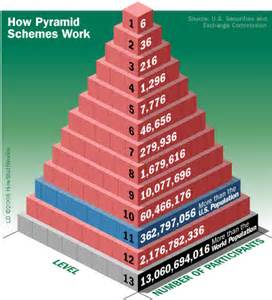Some time back ZBIN once covered the issue of Pyramid Schemes and cautioned our members about MMM. Some came out with guns blazing defending the MMM scheme despite our argument that this was a clear fraudulent scheme!
So where is MMM now? The scheme is dead and buried and a lot of investors lost a lot of money through the scheme. So how did they manage to fool everyone? Its easy they made a few people rich, the few people inspired everyone and soon it became free for all with everyone scrambling to join the scheme! We do not have statistics about how much was lost since it was an underground scheme but we suspect that as much as $6m was lost through this scheme.
There is currently no known pyramid scheme that is running publicly but we know that it’s a matter of time before a new scheme comes to town. It looks like these schemes come in cycles….money related or naked schemes where members part with hard cash and product related schemes were members of the public are hoodwinked by joining schemes where they sell products. After a cash/naked pyramid scheme fails it is usually followed by a product pyramid and so we expect a product related pyramid scheme to follow the MMM scheme in 2017.
Lets look at an article below explaining how a Pyramid Scheme works.
Pyramid schemes quickly become unsustainable.
The main characteristic of a pyramid scheme is that participants only make money by recruiting more members. There are many different kinds of pyramid schemes, but the two most basic are product-based and so-called naked pyramid schemes.
In a naked pyramid scheme, no product is sold. Here’s how it works:
- One person recruits 10 other people to participate in a “no-fail investment opportunity.”
- The 10 recruits each pay the recruiter $100.
- The recruiter now tells them to go out and recruit 10 more people to do the same.
- If each recruit is successful, they’ll all end up with $900 in profit from a $100 investment.
Sounds simple enough, but here’s the problem: Let’s say the initial 10 recruits each find 10 more people. Those 100 new recruits will have to find 10 recruits each to make $900. That means they have to find 1,000 people willing to sign up for the program. And if they somehow find 1,000 people, that next level of the pyramid will need to sign up 10,000 to make a profit. Eventually, there won’t be enough recruits at the bottom of the pyramid to support the level above it. That’s when the pyramid topples and everyone at the bottom loses their investment.

A product-based pyramid scheme is the same concept disguised as a legitimate direct sales opportunity. Here’s how it works:
- A distributor recruits 10 salespeople who each pay $500 for a starter kit of products to sell.
- The distributor gets 10 percent of each starter kit that’s sold.
- The distributor also gets 10 percent of each product that any of his recruits sells, including more starter kits.
- The recruits are told that the fastest way to make money isn’t by selling products, but by recruiting more people to buy starter kits.
- The people at the top of the pyramid get commissions from everyone in their downline, the many levels of recruits below them on the pyramid.
The problem with most product-based pyramid schemes is that the products themselves don’t sell very well, or have very slim profit margins. So the only way to make money is to find more recruits. Eventually (and surprisingly quickly), the market becomes saturated. There are too many people trying to sell the same unattractive product and there’s no one left to be recruited.
It’s mathematically impossible for everyone to make money in a pyramid scheme. For example, if each recruit needs to find 10 more people to recoup the cost of his or her initial investment, the eighth level of the pyramid would have to recruit a billion people to make back their money. And the next level would need 10 billion, nearly twice the population of the Earth.
In fact, pyramid schemes don’t work unless somebody loses. Those at the bottom of the pyramid are essentially defrauded by those on top. It’s a mathematical fact that no matter how many people join a pyramid scheme, 88 percent of the members will be on the bottom level and will lose their money [source: Pyramid Scheme Alert]. Pyramid schemes are illegal because people don’t lose their money due to normal market forces, but because the system requires them to lose so that a few at the top will win.
Studies show that in a naked pyramid scheme, 90.4 percent of people lose their money, while in product-based pyramid schemes, that number jumps to a shocking 99.88 percent
So what’s the difference between product-based pyramid schemes and legitimate multi-level marketing (MLM) companies? Or is there even such a thing as a legitimate MLM? For Multi-level market (MLM) or network marketing is an American institution. Companies like Amway, Tupperware, Herbalife, Avon, Mary Kay and The Pampered Chef support huge networks of distributors and recruits who sell every type of product from dietary supplements to kitchenware to beauty products. Salespeople are called independent business owners (IBO) and generally work from their homes.
On the surface, it’s hard to tell the difference between a legitimate MLM and a pyramid scheme. That’s because they’re both built on the business model of “multiple levels” of distributors and recruits. Some critics of MLMs claim that all of them, even the supposedly “legitimate” ones, are pyramid schemes in disguise.
Here are some other ways to identify product-based pyramid schemes:
- Pyramid schemes offer money for simply recruiting people. This money can come as a commission from the sale of a starter kit or as a recruiting “bonus.”
- Avoid any MLM that puts much more emphasis on recruiting salespeople than selling the actual product.
- Pyramid schemes charge steep startup costs for joining, including mandatory training, a starter kit and a non-refundable membership fee.
- Beware of any MLM that allows five or more levels of distributors to collect commissions on a single sale.
- Make sure that the products being sold have real value and a competitive price. Are they reputable brands? Have the manufacturers been involved in recent lawsuits?
- Avoid MLMs that only sell lists of sales leads to other MLM salespeople. This is most likely outdated information that has made the MLM rounds several times before.
- Avoid signing up for an MLM as part of a high-pressure motivational event. Consider the information carefully and take it home to think about it.
- Be wary of anyone who tries to sell you on an MLM by flaunting their personal wealth. Realize that many of the people who claim to have made millions through MLM have actually made their money selling books and videos on how to make millions through MLMs.
- Bottom line: If it sounds too good to be true, then it probably is.
![]()





